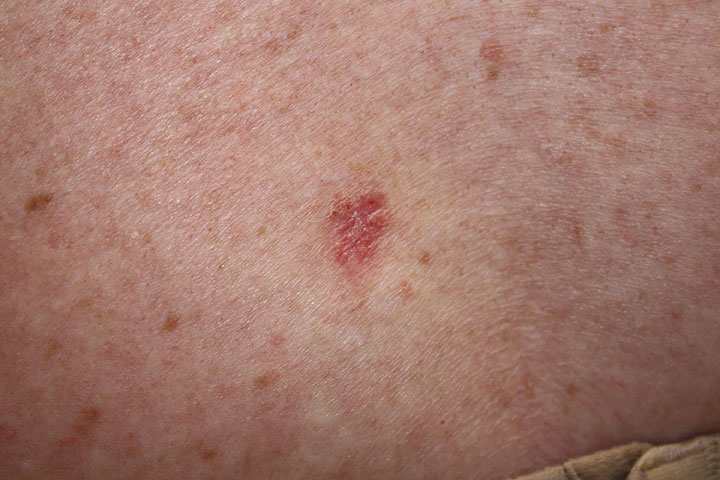Basal cell carcinoma pathophysiology: Difference between revisions
| Line 71: | Line 71: | ||
*Most common on the trunk | *Most common on the trunk | ||
| | | | ||
[[File:Basal cell carcinoma, superficial.jpg|thumb|200px| | [[File:Basal cell carcinoma, superficial.jpg|thumb|200px|Kelly Nelson (Photographer) [Public domain], via Wikimedia Commons,https://upload.wikimedia.org/wikipedia/commons/3/32/Basal_cell_carcinoma%2C_superficial.jpg]] | ||
| | | | ||
*Multiple lobular foci of basaloid palisading keratinocyte tumors | *Multiple lobular foci of basaloid palisading keratinocyte tumors | ||
Revision as of 18:05, 15 February 2019
|
Basal cell carcinoma Microchapters |
|
Diagnosis |
|---|
|
Case Studies |
|
Basal cell carcinoma pathophysiology On the Web |
|
American Roentgen Ray Society Images of Basal cell carcinoma pathophysiology |
|
Risk calculators and risk factors for Basal cell carcinoma pathophysiology |
Editor-In-Chief: C. Michael Gibson, M.S., M.D. [1];Associate Editor(s)-in-Chief: Shivali Marketkar, M.B.B.S. [2]
Overview
Basal cell carcinomas develop in the basal cell layer of the skin. Cumulative DNA damage caused by chronic sunlight exposure results in DNA mutations that predispose to the development of basal cell carcinoma. On gross pathology, basal cell carcinoma lesions may demonstrate pearly pink nodules with telangiectasias, rolled borders, and central crusting with or without an ulcerating lesion (rodent ulcer). On microscopic analysis, peripheral palisading nuclei are characteristic.
Pathophysiology
Genetics
- A number of aberrations involving the sonic hedgehog signaling pathway(SHH) are noted[1][2][3]
- This pathway is vital for the regulation of cell growth, and differentiation and loss of inhibition of this pathway is associated with development of basal cell cancer
- The majority of mutations in sporadic basal cell carcinoma and basal cell nevus syndrome(BCNS) patients occur in PTCH1 gene(a protein that inhibits Smoothened gene(SMO))
- The second most common mutation in sporadic basal cell carcinoma and basal cell nevus syndrome(BCNS) patients are gain-of-function mutations of the Smoothened gene(SMO)
- Loss of PTCH1 results in the failure of Smoothened inhibition, subsecuently leading to increases in GLI1 levels, changes in transcription, and subsequent tumorigenesis
- Gain-of-function Smoothened(SMO) mutations also leads to increased GLI1 levels and tumorigenesis
| Loss of PTCH1 | Gain of function SMO | ||||||||||||||||||||||||
| Lack of SMO inhibition | Activation of SMO-GLI signaling | ||||||||||||||||||||||||
| ↑GLI1 levels | |||||||||||||||||||||||||
| Changes in transcription | |||||||||||||||||||||||||
| Tumorigenesis | |||||||||||||||||||||||||
Enviromental Exposure
- Basal cell carcinomas develop in the basal cell layer of the skin
- Cumulative DNA damage caused by chronic sunlight exposure results in DNA mutations that predispose to the development of basal cell carcinoma
- While DNA repair eliminates most UV-induced damage, not all cross-links are excised, which eventually results in mutations
- Apart from the mutagenesis, sunlight depresses the local immune system, possibly decreasing immune surveillance for new tumor cells
Pathology
Basal cell carcinoma pathological features mainly depend upon the subtype. The following table summarizes them:[4][5]
| Subtypes of BCC | Gross features | Microscopic features | ||
|---|---|---|---|---|
| Findings | Images | Findings | Images | |
| Nodular |
|
 |
|
 |
| Superficial |
|
 |
|
 |
| Infundibulocystic |
|
|
||
| Fibroepithelial |
|
|
||
| Morpheaform |
|
 |
|
 |
| Infiltrative |
|
 |
|
|
| Micronodular |
|
|
||
| Basosquamous |
|
|
||
Video
{{#ev:youtube|JnJXrFnvOKs}}
References
- ↑ Mohan SV, Chang AL (2014). "Advanced Basal Cell Carcinoma: Epidemiology and Therapeutic Innovations". Curr Dermatol Rep. 3: 40–45. doi:10.1007/s13671-014-0069-y. PMC 3931971. PMID 24587976.
- ↑ Pellegrini C, Maturo MG, Di Nardo L, Ciciarelli V, Gutiérrez García-Rodrigo C, Fargnoli MC (November 2017). "Understanding the Molecular Genetics of Basal Cell Carcinoma". Int J Mol Sci. 18 (11). doi:10.3390/ijms18112485. PMC 5713451. PMID 29165358.
- ↑ Yunoki T, Tabuchi Y, Hirano T, Miwa S, Imura J, Hayashi A (November 2018). "Gene networks in basal cell carcinoma of the eyelid, analyzed using gene expression profiling". Oncol Lett. 16 (5): 6729–6734. doi:10.3892/ol.2018.9484. PMC 6202553. PMID 30405815.
- ↑ Cameron, Michael C.; Lee, Erica; Hibler, Brian P.; Barker, Christopher A.; Mori, Shoko; Cordova, Miguel; Nehal, Kishwer S.; Rossi, Anthony M. (2019). "Basal cell carcinoma". Journal of the American Academy of Dermatology. 80 (2): 303–317. doi:10.1016/j.jaad.2018.03.060. ISSN 0190-9622.
- ↑ Sehgal VN, Chatterjee K, Pandhi D, Khurana A (2014). "Basal cell carcinoma: pathophysiology". Skinmed. 12 (3): 176–81. PMID 25134314.